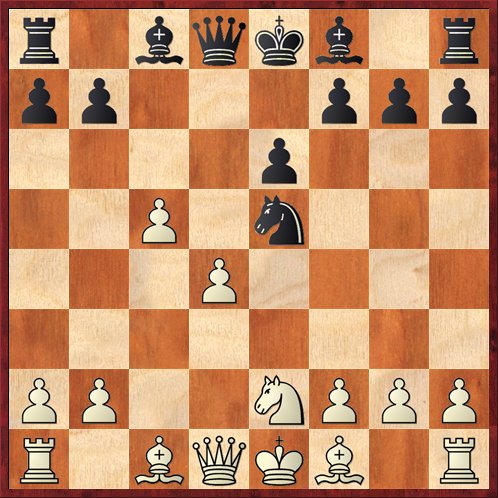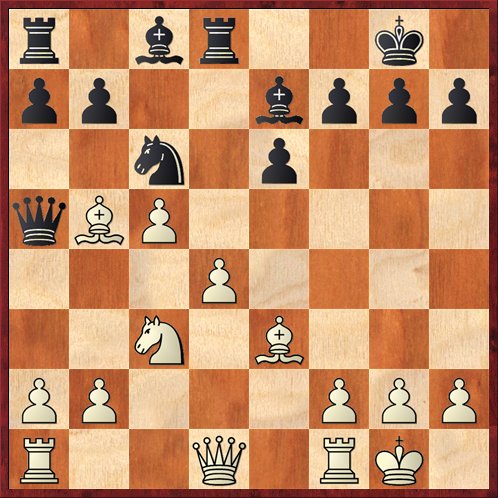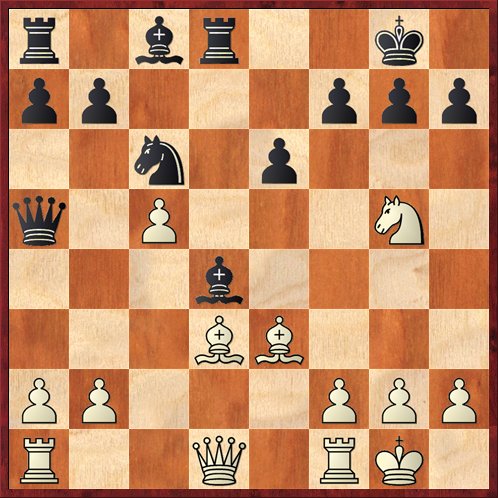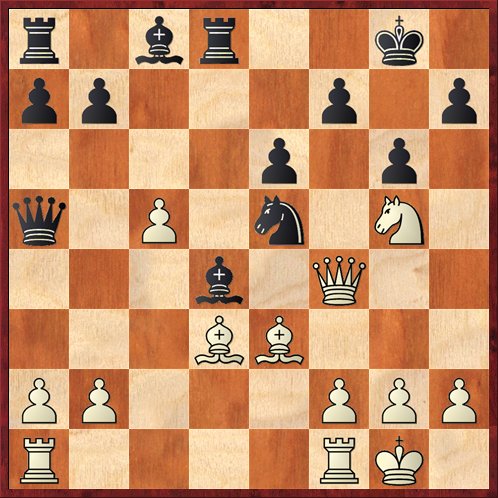On Monday I got together with my friends Gjon, Thadeus, and Cailen for an evening of chess. As we often do, we ended up playing consultation chess — two players to a side, with the players either discussing the moves (which Gjon prefers) or alternating moves without talking (which I prefer, although it sometimes leads to schizophrenic chess when you and your partner have different plans or interpretations of the position). The time control was game in 7 minutes.
Usually Gjon and I play on opposite sides, probably because it seems as if the disparity in strength would be too much if we were both on the same side. (We are both master or master-ish strength, while Cailen and Thadeus are around Class A.) But for a change we did play one game together this time, and I thought it was quite interesting. Perhaps we should do it more often. This game was played with Gjon’s rules — i.e., true consultation, not just alternating moves.
Gjon and Dana — Cailen and Thadeus
1. e4 e6 2. Nf3 d5 3. Nc3 d4
Gjon and I are both aficionados of the unusual Two Knights system for White in the French Defense, although I have lost some of my enthusiasm for it in recent years. Generally I am happy when I see Black play 3. … d4, because I feel as if I have lured him into a pawn structure he will not be as comfortable with. Instead of the usual French pawn structure, where White is fighting to hang onto his center, instead we will have a situation where Black is defending his center.
However, in this case we were playing directly into a line that Cailen had studied, so “general considerations” go out the window. For the next few moves Cailen was calling the shots on the Black side.
4. Ne2 c5 5. c3 Nc6
Not 5. … d3? 6. Nf4 c4 7. Qa4+, a nice little trap that makes this line possible for White.
6. cd Nf6!
A move order I had never seen before, with a very clever point behind it.
7. e5 Nd7 8. dc Ndxe5 9. Nxe5 Nxe5 10. d4 …
Black to move.
Here Black has a very good move. Can you see what it is?
Ironically, Cailen, who had been studying this variation, did not remember the correct move and played 10. … Qa5+? instead. This is the problem with memorizing opening variations: inevitably you forget something (especially in blitz chess) and then you’re stuck with an inferior position.
The correct answer is 10. … Bxc5!! Black immediately recovers his sacrificed pawn, by deliberately moving into a fork! This move was first played by super-GM Shakhriyar Mamedyarov against Gadir Guseinov in 2003. White can’t take either piece: if 11. de then 11. … Bxf2+! wins the queen, and if 11. dc then 11. … Nd3+ 12. Kd2 Nxf2+ again wins the queen. What a lovely concept! Instead White has to just continue developing with 13. Be3 Bb4+ 14. Nc3 etc. Interestingly, Rybka thinks there is nothing wrong with White’s position here, but Guseinov lost, probably because he never recovered from the shock. Black has continued to score about 65 percent in tournament practice. This is a really big problem for anyone wanting to play this variation as White.
Anyway, Cailen failed to remember this, and not being a super-GM he wasn’t able to find it over the board. After 10. … Qa5+ the game continued 11. Nc3 Nc6 12. Bb5 Be7 13. O-O O-O 14. Be3 Rd8 (Diagram 2).
White to move.
Should White play 15. a3 here? What other options does he have?
In spite of Black’s missed opportunity on move 10, he has still developed some significant pressure against White’s center, and the problem arises of how White is going to prevent … Bxc5 without dropping his d-pawn. The original idea — to be honest, kt was Gjon’s original idea — was to play 15. a3, but in this position we started having doubts. Indeed, as Rybka shows, 15. a3 would allow Black to recover his pawn immediately with 15. … Nxd4! 16. Bxd4 Bf6. After we had debated for a while, Gjon said, “Hey, what about 15. Bd3?”
“I like it!” I said, and thereupon immediately played 15. Bd3 and hit the clock without further analysis!
Cailen and Thadeus thought this was pretty funny, that we spent all our time talking about one move and then impulsively played another. This is actually a very poor thought pattern, but it turned out that we were right! Rybka actually thinks that 15. Bd3 is White’s best move. Of course it sets an obvious trap — Black can’t take on d4 right away because 15. … Nxd4? 16. Bxd4 Rxd4 17. Bxh7+ wins the exchange. At the same time, it breaks the pin and most importantly, it focuses attention on the kingside, where Black’s king is sitting naked. I think it also appealed to me because it is paradoxical, and I love paradoxical moves. White’s pawn on d4 is under pressure, and he replies by playing a move that weakens d4!
But — giving credit where credit is due — it was Gjon’s idea.
Now Black should play 15. … g6!, which defuses the Bxh7+ threat and also takes away White’s ideas of Qh5. However, Cailen and Thadeus understandably wanted to play more actively, and chose 15. … Bf6 instead. Here the computer recommends 16. Nb5, but Gjon and I … well, mostly me in this case … were more interested in the kingside, and played the over-ambitious 16. Ne4? instead.
Cailen and Thadeus replied 16. … Bxd4 17. Ng5, and now a critical position is reached.
Black to move.
What is Black’s best defense?
I was completely wrong about this position. The move I was most worried about was 17. … Bxe3?, which is a mistake. The first thing to notice is that 18. Bxh7+? Kf8 is bad for White because his queen and his knight on g5 are both en prise. However, the simple recapture 18. fe is very good for White. The point is that White now has four attackers — the bishop, knight, queen, and rook — against no Black defenders, and that is enough to mate. The key line, which we found in the postmortem without computer help, is 17. … Bxe3 18. fe f5 19. Qh5 h6 20. Rxf5!! ef 21. Bc4+ Kh8 22. Qg6 and mate next move.
So Black must, above all, resist the temptation to trade bishops, because it lets an extra attacker into the game. If he doesn’t play 17. … Be3, then White’s rooks are mere bystanders. Instead Black’s best move is 17. … h6! After 18. Qh5 hg 19. Qh7+ Kf8 20. Qh8+ Ke7 21. Bxg5+ Black has two good choices. He can play 21. … Bf6 22. Qxg7 Bxg5 23. Qxg5+ when White has to settle for a draw by perpetual check. Or Black can play to win with 21. … Kd7 22. Bxd8 Qxd8. White is unable to hold the pawn on c5, so Black will emerge with two pieces for a rook. Although Black’s king is a little exposed, it’s not enough to give White compensation for the material.
However, with very little time to work through the complications (remember, it’s a 7-minute game), Cailen and Thadeus chose 17. … g6, which is okay but less forcing than 17. … h6. Now Gjon and I played 18. Qf3 Ne5 19. Qf4?!
Amusingly, our thought pattern here was similar to move 15. At first Gjon wanted to play 19. Qf6, but it made me nervous to put our queen on the same diagonal as the Black bishop. After we debated for a bit, Gjon said, “Well, there’s also 19. Qf4.” Mindful of the clock (we now had less than a minute left), I said, “Yes! Let’s play that!” and played the move without any more analysis. But in this case, my intuition was faulty: the computer says that 19. Qf6 is a stronger move.
Black to play.
White has two pawns hanging: Which one should Black take?
Actually I have asked the wrong question here. The right question is this. Black’s dark squares are dangerously weak. What is his best way to maintain control over them? When you ask the question this way, it becomes evident that Black wants to retain his dark-squared bishop at all costs. It just so happens that he can do this and also pick up a loose button at the same time, with 19. … Bxb2! after which it’s hard for White to demonstrate compensation for the pawn.
Cailen and Thadeus were by now extremely low on time, too, and they played 19. … Qxc5? instead. Although this doesn’t necessarily lose, it’s the wrong idea. Gjon was already whispering in my ear “Qh4!” even before they completed their move. Sure enough, after 20. Qh4! Black has a problem. He has to prevent check on h7, but also his rook on d8 is loose. After 20. … h5 21. Ne4 we get to the last critical position.
Black to move.
Cailen and Thadeus, who were now down to just seconds, played 21. … Qf8?, which lost immediately to 22. Bxd4 Rxd4 23. Nf6+ Kg7 24. Qxd4 Kxf6 25. f4, and Black’s flag fell a couple of moves later.
Black could have continued fighting with 21. … Qb6, which defends both weak points (d8 and d4), but White still has a very dangerous attack because of Black’s weak kingside. Some Rybka-generated best play goes as follows: 22. Bg5! Bd7! (It’s more important for Black to finish developing than to save the exchange) 23. Be2! (Likewise, White is more interested in attacking than in winning material) Bc6 24. Nf6+ Kg7 25. Rad1 Qxb2 (This is a “What else?” sort of move. Black can’t hold his leaky ship together, so he might as well grab all the material he can.) 26. Nxh5+ gh 27. Bxd8 Qxe2 28. Rxd4 with about a one-pawn advantage for White, according to the computer.
All in all, an exciting game with some nice, instructive motifs for attacking a castled king who is without defenders. Also instructive here is the way that Black never got his queenside pieces (the QR and QB) into the game. So many times that is a recipe for defeat in e-pawn openings. On the White side the mistakes were mostly mine, not Gjon’s, and they had to do with making decisions impulsively and emotionally rather than for sound analytical reasons.








{ 1 comment… read it below or add one }
Hi Dana,
I just wanted to write in support of the training benefit that comes with playing “consultation chess”. (Did we try this at Kenyon?) Anyway, I played several games of this in NJ with NM Vincent Klemm and friends. What a great way to force yourself to analyze stuff you wouldn’t normally play. On the one hand it certainly highlights the need for coordination. On the other hand, being confronted with situations that one didn’t plan for can help prepare a person for those inevitable nasty surprises that occur in one’s games. Sometimes all is not lost! Plus, its just fun and comes without the pressure of a rated result.
We never played timed, but we did have a beer or two.